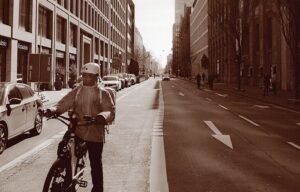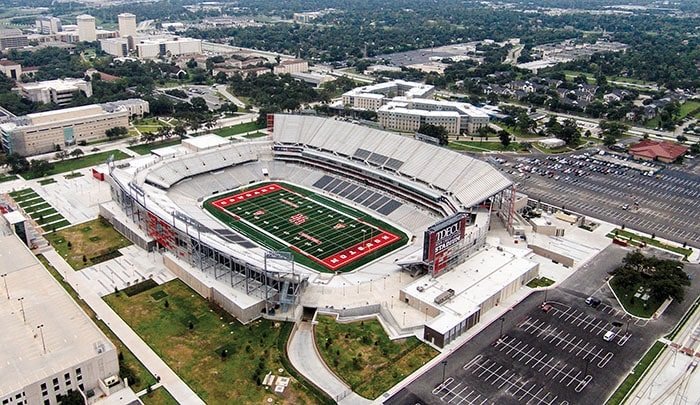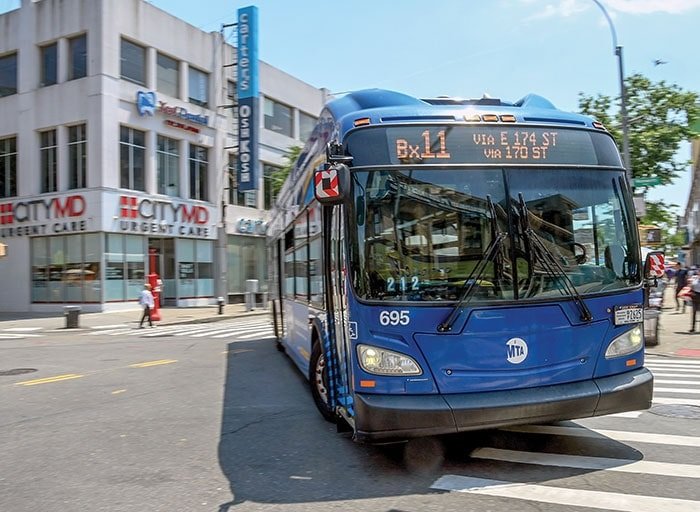Protecting Pedestrians Through Parking Enforcement
By Jay Landers
With pedestrian fatalities on the rise in the United States, a groundswell of support has grown for efforts to better protect people on foot and cyclists from vehicular traffic. Cities, universities, airports, and other entities are turning to various approaches for improving traffic safety, including better enforcement of parking regulations in areas at elevated risk for pedestrian injuries.
This trend reflects the growing awareness of the role that parking regulations can play in helping to protect vulnerable road users, particularly in critical locations such as crosswalks, bike lanes, and no-parking zones near public transportation areas. However, these regulations are only effective if enforced consistently.
Historically, consistent, continuous enforcement of parking regulations has been difficult, time-consuming, and labor-intensive. Fortunately, recent advancements in automated parking enforcement technologies are alleviating these limitations, enabling municipalities and others to implement consistent, cost-effective enforcement solutions that can reduce pedestrian deaths and injuries.
These advances in parking enforcement, coupled with a growing awareness of pedestrian vulnerabilities, are highlighting the potential for the parking industry to play a greater role in improving safety outcomes.
Pedestrian Fatalities Rising
Between 2013 and 2022 — the most recent year for which statistics are available — the number of pedestrian fatalities in the United States rose by 57%, from 4,779 to 7,522, according to the July 2024 “Traffic Safety Facts” bulletin produced by the National Highway Traffic Safety Administration (NHTSA) within the U.S. Department of Transportation.

The number of pedestrian fatalities in 2022 was the highest since 1981, when 7,837 pedestrians died in traffic crashes. In 2022, pedestrians accounted for 18% of all U.S. traffic fatalities, according to the NHTSA. In that same year, pedestrian injuries totaled 67,336 in the United States, an 11% increase over 2021.
“With more than 7,000 pedestrians killed each year on our nation’s streets, the problem is severe,” said Dan Hennessey, the director of the Transportation & Public Works Department in Santa Rosa, California. “To put this into perspective, more than 20 people die every day after being struck by vehicles while walking,” Hennessey said.
Unsafe Parking Practices
Pedestrians are particularly vulnerable in urban environments, where traffic, parked vehicles, and infrastructure overlap. Many accidents occur in densely populated areas, where vulnerable road users and parked cars coexist on narrow streets.
Several types of parking violations can directly endanger both pedestrians and non-pedestrians, and strict enforcement can mitigate these risks:
- Parking in crosswalks and near intersections
- Double parking
- Blocking sidewalks and pedestrian paths
- Blocking bike lanes
- Blocking fire hydrants
- Blocking emergency medical service travel paths and fire lanes
When vehicles park in or too close to crosswalks and intersections, they obstruct the view for both pedestrians and oncoming vehicles, making it difficult for both parties to see each other. Vehicles parked too close to intersections can block the view of drivers attempting to make turns and impede pedestrian visibility. These issues are especially dangerous at night or in poorly lit areas.
“One of the major design issues we face in creating safe streets is the desire for and placement of on-street parking,” Hennessey said. “Ensuring that on-street parking is set back from intersections and crosswalks improves sight lines for all road users, leading to safer decisions.”
Parking enforcement can prevent vehicles from encroaching on crosswalks and intersections, enhancing visibility and reducing the risk of accidents.
Double parking forces pedestrians to step out from between vehicles and into active traffic lanes to cross streets or get to their destinations. The risk of being struck by a moving vehicle increases significantly when pedestrians are forced into vehicular paths. Stronger enforcement of double-parking regulations can keep streets clearer, giving pedestrians safer, unobstructed routes.
Vehicles that block sidewalks and curb cuts create obstacles for pedestrians, especially those with disabilities. Pedestrians are forced to move into the street, putting them at greater risk. Regular enforcement of these violations not only ensures accessibility but also minimizes the danger of pedestrian-vehicle collisions.
With the growing adoption of multimodal transport, bike lanes have become integral parts of many cities’ transportation networks. However, when vehicles block these lanes, it forces cyclists into traffic, putting both cyclists and pedestrians at risk, as sidewalks and bike paths often run parallel. Enforcing parking restrictions in bike lanes protects all non-vehicular road users.
Technologies to Improve Safety
The increasing availability and affordability of advanced technological solutions are transforming how parking violations are monitored and enforced. These innovations not only make it easier for municipalities to manage parking but also directly improve pedestrian safety by increasing adherence to parking regulations:
- In-ground parking sensors
- Automated license plate recognition (ALPR)
- Camera-based vehicle detection
- Mobile apps and crowdsourced digital reporting
In-ground parking sensors can detect when and for how long a vehicle is parked. These sensors can be integrated with mobile apps or handheld devices used by enforcement officers, providing them with up-to-the-minute information on violations. In dense urban areas, data from in-ground sensors can ensure that parking regulations are regularly upheld while enforcement officers are on duty, particularly in locations where pedestrian traffic is high, such as near schools, parks, and retail centers.
ALPR systems can quickly scan and record license plate and location information to detect parking violations in real time. This technology enables parking enforcement officers to monitor more areas in less time, catching violations that might otherwise go unnoticed. ALPR can be mounted on enforcement vehicles, transit vehicles, or stationary cameras, enabling continuous surveillance of areas with high pedestrian activity. These systems can instantly flag cars that are illegally parked in crosswalks, bus stops, or bike lanes, leading to more immediate corrective action.
Camera-based enforcement has become an essential tool in some cities for monitoring bus lanes, intersections, loading zones, or other dynamically defined areas. These cameras can also be used to automatically send parking tickets for violations of parking restrictions in areas critical to pedestrian safety, such as crosswalks and no-parking zones. This form of enforcement is highly effective in high-traffic areas where traditional patrolling is challenging.
Some municipalities have developed mobile apps or other reporting tools to enable citizens to report parking violations. In other cities, citizens have created forums to crowdsource information to share with the city. Using these methods, residents can quickly and easily report blocked crosswalks, double-parked vehicles, or cars obstructing sidewalks, providing enforcement officers with actionable data.
In short, automated monitoring and enforcement solutions that operate continuously help to deter illegal parking, streamline parking enforcement operations, and support safer streets for all users.
Funding for Safer Streets and Roads
In certain cases, the use of automated continuous parking monitoring systems can help U.S. entities secure grant funding from the federal Safer Streets and Roads for All program. Created by the Infrastructure Investment and Jobs Act and overseen by the U.S. Department of Transportation (DOT), the Safer Streets and Roads for All program funds regional, local, and tribal initiatives through grants to prevent roadway deaths and serious injuries.
Municipalities and other interested parties can apply for grants both to test and gather data about the extent to which automated enforcement systems improve pedestrian safety. If successful, this data can be used to obtain additional grant dollars to expand the enforcement program.
Transforming Parking
Users of automated enforcement solutions can help to improve pedestrian safety beyond their own jurisdictions by sharing pertinent data and insights with groups like the Vision Zero Network. A nonprofit organization, the Vision Zero Network is dedicated to achieving the goal of zero traffic deaths and severe injuries among all road users.
The parking industry itself should lead the transformation to greater safety, said David Nevarez, the Engineering Programs Administrator of the Transportation Division within the Planning and Development Department of the City of Dallas. “Parking design professionals play a significant role in improving pedestrian safety,” he noted. “We are responsible for creating environments that minimize the risk and severity of vehicle-pedestrian collisions. While serving the needs of motor vehicle facilities, our sector must also develop strategies that support alternative modes of transportation.”
Opportunity for Change
As technology progresses, the tools available to parking professionals only increase. Although improving parking efficiency, customer service, and parker compliance are key goals for many parking operations, the ability to improve pedestrian safety and gather real-time mobility data can now be added to that list.
Although the connection between parking and pedestrian safety is not always top of mind, the adoption of new technologies can enable the parking industry to change that perception and potentially help save lives.
Jay Landers is the editor-in-chief of Parking Today. He can be reached at jay@parkingtoday.com.











